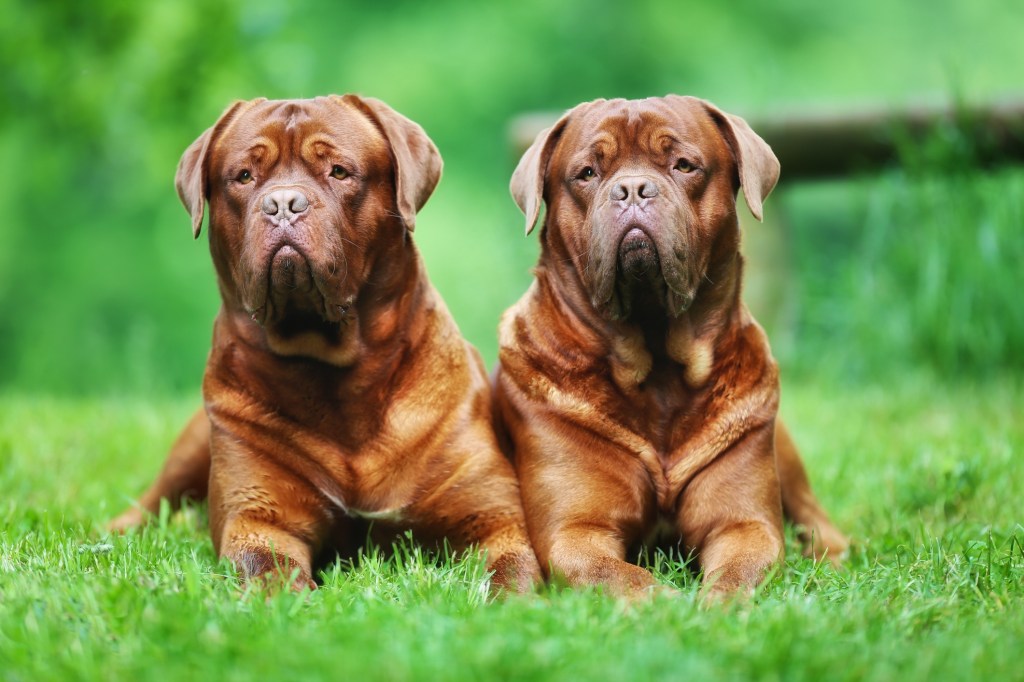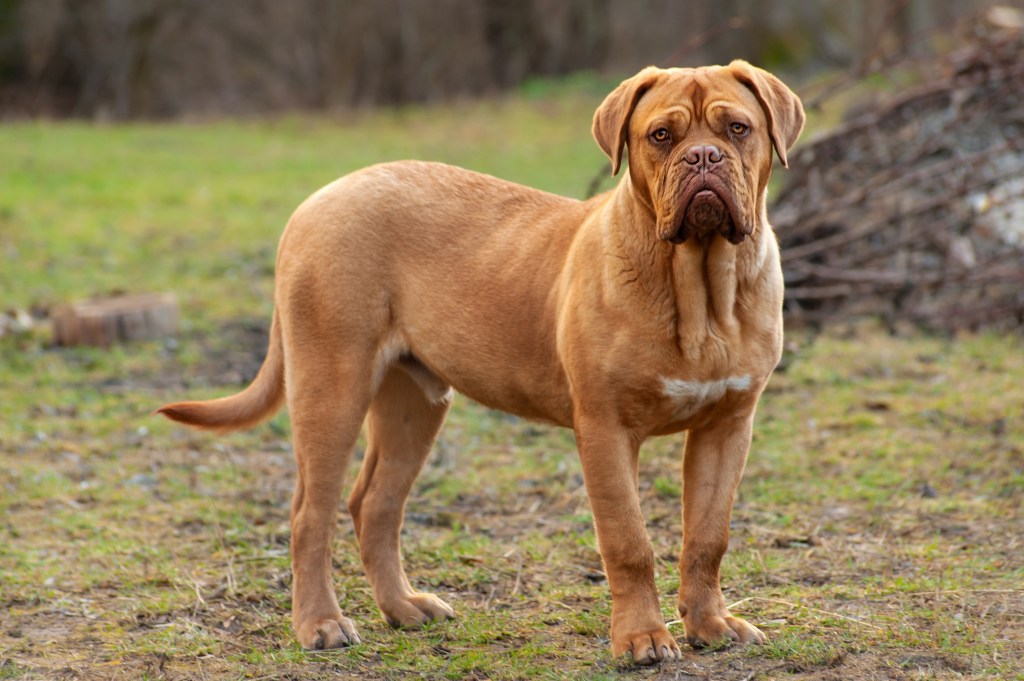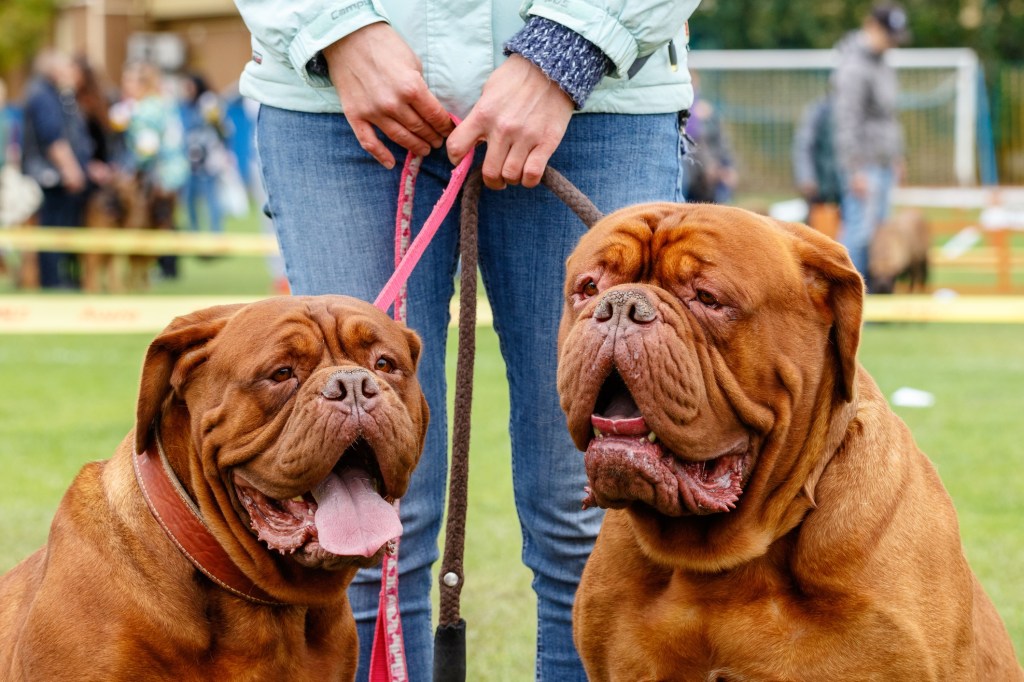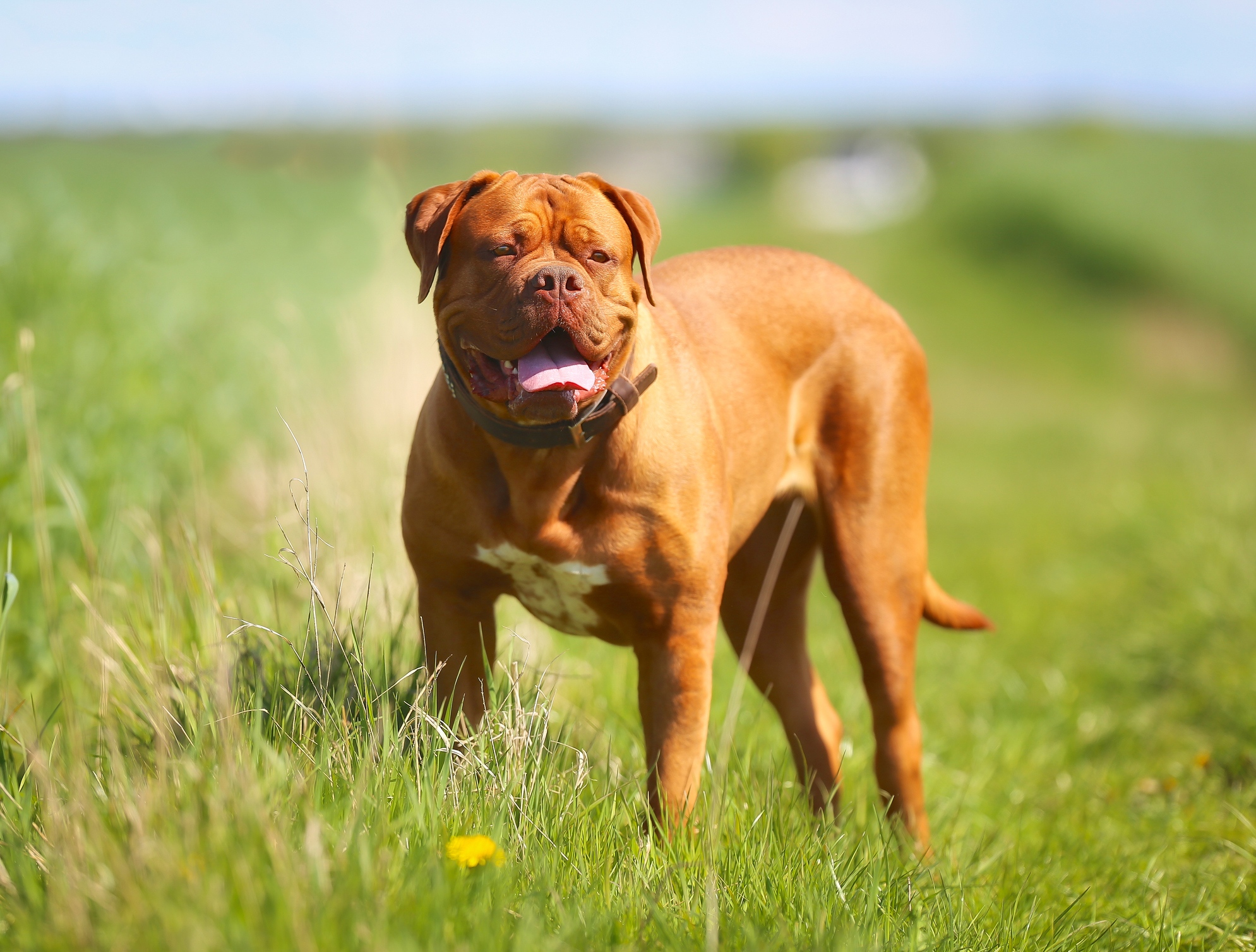Table of Contents
Introduction to the Dogue de Bordeaux
The Dogue de Bordeaux is a breed that also goes by the names French mastiff and Bordeaux mastiff. This is a large breed that some people may recognize from the 1989 movie “Turner & Hooch.” The origin of the Dogue de Bourdeaux is France, and the breed is known for its immense loyalty, large head, and sensitive soul.
To learn more about the Dogue de Bourdeaux and if this is the right kind of dog for your household, this breed guide is for you! We’ll also cover how to take the best care of your Dogue de Bordeaux’s health, including the important step of enrolling your dog in our pet health insurance plan.
Size of a Dogue de Bordeaux
Dogues are large, Working Group dogs that typically weigh at least 99 pounds as females and at least 110 pounds as males. Females of this breed stand 23 to 26 inches tall, and males are 23 to 27 inches tall when fully grown. These dogs usually stop growing by around 19 months of age.
Here’s how big you can expect your Dogue de Bordeaux to get as the dog grows from puppyhood to adulthood. Females may weigh slightly less than these averages and males slightly more.
| Weight Chart | 3 months | 6 months | 9 months | 12 months |
| Averages for male and female Dogue de Bordeaux dogs | 44 lbs. | 77 lbs. | 105 lbs. | 116 lbs. |

Characteristics of a Dogue de Bordeaux
The most noticeable physical characteristics of a Dogue de Bordeaux involve the dog’s size, as these are large and muscular dogs that are stocky and powerful. They are affectionate by nature, making them excellent family dogs. However, they can also be stubborn, which can make training a challenge. Other common characteristics of the Dogue de Bourdeaux include being territorial, loyal, self-confident, docile, and sweet.
People gravitate towards this dog breed because it is known to be patient and tolerant with children while also having relatively low energy that can be satisfied with only moderate exercise. These dogs are alert, have a formidable appearance, and are wary of strangers, making them ideal watchdogs too. Yet they are not overly dog-friendly, so it’s often best to have a Dogue de Bourdeaux as the only dog in the house.
As you get to know a Dogue de Bordeaux’s personality, here’s what you can expect based on his or her breed characteristics:
| Breed Characteristic | Level (High, Medium, Low) |
| Affectionate with Family | High |
| Good with Kids | High |
| Good with Pets | Low |
| Need for Exercise | Medium |
| Energy Level | Low |
| Intelligence Level | Medium |
| Able to Be Trained | Medium |
| Amount of Barking | Low |
| Amount of Shedding | Medium |
History of the Dogue de Bordeaux
The history of the Dogue de Bordeaux takes us to France, where historians believe it is an indigenous French breed developed thousands of years ago. Bordeaux is a region in southwestern France where the dogs were bred to guard vineyards, estates, and castles. Potentially close ancestors of the Dogue de Bordeaux are the Neapolitan mastiff, Tibetan mastiff, and Greek mastiff. Romans used Dogues as war dogs to go to battle alongside gladiators and wild beasts in arenas. There were two size variations of the breed for a while before the smaller variety ceased to exist.
Over time, Dogues were used for fighting, hunting, and guarding. They were a choice breed for guarding the estates of nobility in the late 1700s. They were nicknamed the “butcher’s dog” for their work as livestock drovers. The French Kennel Club officially recognized the breed in 1863 and established the first breed standard.
The Dogue de Bordeaux only became popular in other parts of the world besides France in 1989 when the Tom Hanks comedy “Turner & Hooch” came onto the big screen. The American Kennel Club did not recognize the breed until 2008. Today, Dogues are typically household family dogs and beloved gentle companions.

Dogue de Bordeaux Standard Information
The general appearance of a Dogue de Bordeaux includes the dog having a massive head, serious expression, and athletic build. It is a self-assured dog that is built close to the ground and that has a rather similar appearance between males and females.
Here is an overview of the breed standard information for the Dogue de Bordeaux:
Head:
- Large, broad, and angular head
- Hazel to dark brown eyes for dogs with black masks and lighter colors in dogs with brown or no masks
- Proportionally small ears
- Powerful, broad, and thick muzzle
- Undershot bite
- Strong canine teeth
Neck, Topline, Body:
- Almost cylindrical neck
- Supple and loose neck skin
- Loin is broad and rather short
- Tail is very thick at the base and carried low
- Chest is long, deep, and broad
Forequarters:
- Very muscular upper arms
- Elbows in line with the body
- Powerful pasterns
- Toes tight with nails curved and pads supple
Hindquarters:
- Well-angulated legs with strong bone structure
- Thick upper thigh with visible muscles
- Short and sinewy hock joint
- Hind feet slightly longer than front feet
Coat:
- Fine, short, and soft coat
- Loose-fitting skin but without excessive wrinkles
Color:
- All shades of fawn, from dark red to light
- Rich coat color is desirable
- White patches are allowed but not preferred
Gait:
- Free and supple gait that is close to the ground
- Head drops as gait quickens
- Capable of great speed over short distances
Caring for a Dogue de Bordeaux
Despite its size, a Dogue de Bourdeaux can live comfortably in an apartment because of its low-to-moderate energy and exercise needs. Although this dog does not necessarily need a yard and is fairly inactive indoors, it is still important to get out for long daily walks.
Here are some general tips for taking the best care of a Dogue de Bordeaux:
Best Living Environments:
- Adaptable dogs to various environments
- Apartments are ok if exercised daily
- No yard is necessary
- Sensitive to heat, so it is important to keep the dog cool in summer
Type of Exercise:
- Long daily walks
- Daily play sessions
- Calm and relaxed style of exercise
Mental Enrichment:
- Play sessions with family members
- Toys to chew
- Puzzles to figure out
Training Strategies:
- Stimulate the dog physically and mentally to prevent behavior issues
- Independent thinkers and a strong will
- Establish boundaries and practice firm training
- Use positive reinforcement methods
Grooming Tips:
- Very little grooming is needed
- Keep skin folds clean to prevent infection

Common Health Problems of a Dogue de Bordeaux
The Dogue de Bordeaux has one of the shortest average life spans of all dog breeds: just five to eight years. Therefore, it is important to sign your dog up for pet health insurance as early as possible to address medical conditions as they arise.
These are some of the most common health issues that arise with a Dogue de Bordeaux:
- Brachycephalic obstructive airway syndrome
- Hip dysplasia
- Elbow dysplasia
- Dilated cardiomyopathy, subaortic stenosis, and other heart issues
- Entropion and other eyelid abnormalities
- Bloat (gastric dilation-volvulus)
- Skin allergies and skin fold dermatitis
Diet and Nutrition for a Dogue de Bordeaux
The Dogue de Bordeaux is a breed that is prone to weight gain, so you will need to measure out daily servings instead of leaving food out at all times for your pet to graze. An adult Dogue de Bordeaux typically needs four to five cups of dry dog food per day based on weight and activity level, but your dog’s exact requirements will vary based on their exercise level and the caloric density of their dog food. Begin by following the label recommendations on your dog’s food as a general guideline, then increase or decrease as needed to maintain a healthy weight.
Where to Adopt or Purchase a Dogue de Bordeaux
The Dogue de Bordeaux Society of America is the parent breed club for this dog and a member of the American Kennel Club. On the organization’s website, you can read information about finding a breeder, and the AKC Marketplace lists 100 percent AKC-registered litters and breeders who adhere to the AKC’s standards.
There are also Dogue de Bordeaux-specific rescue groups that help dogs of this breed find loving homes. The Dogue de Bordeaux Society of America and Dogue de Bordeaux Rescue, Inc. are national organizations and good resources for adoption.
Related Breeds
Has the Dogue de Bordeaux breed captured your heart? If so, there are other similar types of dogs that you might consider learning about too before making the decision to bring a new pet into your life, such as these:
- Mastiff
- Bullmastiff
- Neapolitan mastiff
- Cane corso
Pet Insurance for a Dogue de Bordeaux
To make the very most of your Dogue de Bordeaux’s estimated five to eight years of life, it’s important to prioritize preventative care and think ahead about potential health issues. Healthy Paws is pleased to offer Dogue de Bordeaux insurance to cover new accidents and illnesses with customizable pricing and fast reimbursement. There are no annual or lifetime caps and just one easy-to-understand policy with no costly add-ons.
Request your Dogue de Bordeaux quote today to learn more about our coverage and the types of vet bills it pays for.









